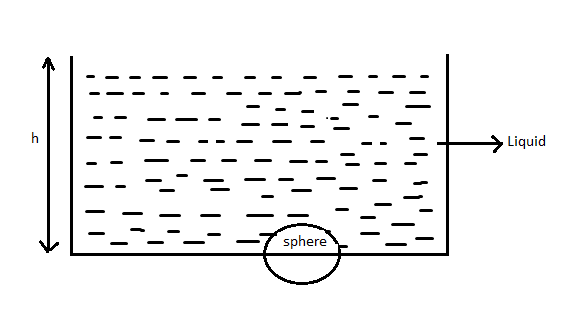
The volume of a sphere inside the liquid is $V$.
The sphere plugs a circular hole of radius $r$. What is the force of buoyancy of the sphere?

Answer
219.6k+ views
Hint: For a body immersed in a liquid, the thrust acting on the bottom surface will be greater than the thrust on the top surface. But the thrust on the top surface is downwards and that on the bottom surface is upwards. Hence the body will experience an upward thrust. This is called the buoyant force.
Complete step by step solution:
The buoyant force is the reason why objects float on liquids. We feel objects weigh less underwater because of buoyant force. The reason for buoyant force is the difference in pressure on both sides of the object immersed in a fluid that is in rest. The phenomenon of objects showing buoyant force is called buoyancy.
The force of buoyancy depends on the volume of the fluid, the density of the fluid and the acceleration due to gravity.
Let ${V_l}$ be the volume of the given liquid. Then the buoyant force acting on the sphere can be written as
${F_b} = - \rho g{V_l}$
where ${F_b}$ stands for the buoyant force, $\rho $ stands for the density of the fluid, $g$ stands for the acceleration due to gravity and ${V_l}$ stands for the volume of the liquid.
The negative sign is because the direction of the buoyant force will be opposite to the direction of gravitational force.
Note: There is a particular point on the object where the force of buoyancy acts. This point is called the centre of buoyancy. The upward force exerted by the liquid on the object is also called upthrust. The buoyant force is utilized by swimmers, birds, aquatic animals etc. The principle of submarines, aeroplanes, etc is based on the concept of buoyancy.
Complete step by step solution:
The buoyant force is the reason why objects float on liquids. We feel objects weigh less underwater because of buoyant force. The reason for buoyant force is the difference in pressure on both sides of the object immersed in a fluid that is in rest. The phenomenon of objects showing buoyant force is called buoyancy.
The force of buoyancy depends on the volume of the fluid, the density of the fluid and the acceleration due to gravity.
Let ${V_l}$ be the volume of the given liquid. Then the buoyant force acting on the sphere can be written as
${F_b} = - \rho g{V_l}$
where ${F_b}$ stands for the buoyant force, $\rho $ stands for the density of the fluid, $g$ stands for the acceleration due to gravity and ${V_l}$ stands for the volume of the liquid.
The negative sign is because the direction of the buoyant force will be opposite to the direction of gravitational force.
Note: There is a particular point on the object where the force of buoyancy acts. This point is called the centre of buoyancy. The upward force exerted by the liquid on the object is also called upthrust. The buoyant force is utilized by swimmers, birds, aquatic animals etc. The principle of submarines, aeroplanes, etc is based on the concept of buoyancy.
Recently Updated Pages
Chemical Equation - Important Concepts and Tips for JEE

JEE Main 2022 (July 29th Shift 1) Chemistry Question Paper with Answer Key

Conduction Explained: Definition, Examples & Science for Students

Analytical Method of Vector Addition Explained Simply

Atomic Size - Important Concepts and Tips for JEE

JEE Main 2022 (June 29th Shift 1) Maths Question Paper with Answer Key

Trending doubts
JEE Main 2026: Application Form Open, Exam Dates, Syllabus, Eligibility & Question Papers

Understanding Uniform Acceleration in Physics

Derivation of Equation of Trajectory Explained for Students

Hybridisation in Chemistry – Concept, Types & Applications

Understanding the Angle of Deviation in a Prism

Understanding Collisions: Types and Examples for Students

Other Pages
JEE Advanced Marks vs Ranks 2025: Understanding Category-wise Qualifying Marks and Previous Year Cut-offs

Units And Measurements Class 11 Physics Chapter 1 CBSE Notes - 2025-26

NCERT Solutions For Class 11 Physics Chapter 8 Mechanical Properties Of Solids

Motion in a Straight Line Class 11 Physics Chapter 2 CBSE Notes - 2025-26

NCERT Solutions for Class 11 Physics Chapter 7 Gravitation 2025-26

Mechanical Properties of Fluids Class 11 Physics Chapter 9 CBSE Notes - 2025-26




